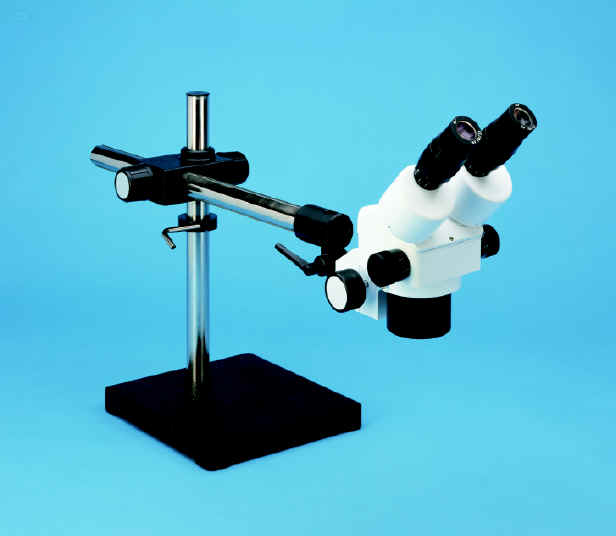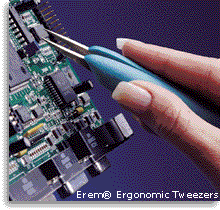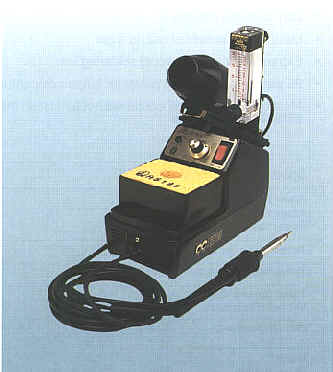|
Many engineers express dismay at having to build a breadboard using components that are only
available in surface mount (SM) packages. Others will go to great lengths to acquire parts
in through-hole versions for their prototypes and then use the SM versions for the production board.
By necessity, I have become very proficient at building prototypes using SM discrete components
and integrated circuits. There is one possible disadvantage that I should point out up front:
your first prototype must be an actual printed circuit board. I don't find this to be a major
problem since I used to go directly from schematic to printed circuit boards even back in the
through-hole days.
I find that there are many advantages to doing the initial boards using SM components:
- The prototype board is the same physical size as the ultimate product. Since the board itself
must be considered a component for many RF boards, this is absolutely necessary.
- The surface mount components are physically smaller than their through-hole equivalents, so
they are less affected by parasitic effects.
- It is easier to change out resistors and capacitors to try different values. You don't have
to get solder out of a plated-through hole. Simply bring the hot air soldering hand piece up to
the part that you want to remove, grasp the part with tweezers, and lift it off.
- You can try different values of discrete components rapidly without solder at all. Just lay
the part across the pads and apply a small pressure with your tweezers in the middle of the part
so you don't contact either end of the part. Observe the 'scope, meter, or whatever instrument
you're using for the change in circuit behavior, and go on to the next value.
- The board lasts through more component changes than a through-hole board. I have had through-hole
pads lift and break after just one unsoldering operation. This rarely happens with a SM board, though
pads with no connections to help dissipate heat will occasionally lift off the board with little provocation!
While a megabuck SM repair station is not necessary (I have gotten along just fine without one), there
are a few bench tools that are essential for SM prototyping. They are listed below, roughly in order
of importance.
- Stereo Microscope.
Anyone who is doing serious SM work must have a good stereo microscope
for soldering, desoldering, inspection, or probing operations. When selecting a microscope, be sure
to pay particular attention to the working distance -- the clearance between the microscope objective
lens and the item that it is focused on. I once worked with an otherwise fabulous microscope that had
only two inches of working distance. Boy, was it ever easy to burn the plastic ring light on that
microscope with a soldering iron! A negative power lens will increase working distance more than it
will decrease the magnification.
Scienscope supplies reasonably priced
stereo microscopes.

- Good tweezers.
Tweezers are next on my list since they are the tool that you will handle most.
I prefer foam cushioned stainless steel tweezers with curved tips like the
Erem E7SA. A good pair of tweezers
will make your life much easier!

- Hot air soldering iron.
A hot air soldering iron is useful both for initial soldering and
for desoldering. My choice of hot air tools is the Edsyn 971HA.
It is one of the less expensive units but is still quite capable. In fact, it has some features
(possibly unintended) that make it easier to use than most hot air soldering tools. The most important
of these is that the air tubing from the base to the handpiece is flexible and runs at a position where
you can squeeze off the air flow with your index finger while moving the iron near to the component that
you wish to work on. This prevents blowing off dozens of components while getting everything arranged
under the microscope! This soldering station is intended for operation with compressed air and it comes
with air handling hookups. I don't have shop air, but rather than pay hundreds of dollars more for a unit
with a built in pump I went to WalMart and bought the largest aquarium air pump they had in stock. With
very simple and reversible modifications, the soldering iron works quite nicely with this air source.
I recommend Howard Electronics as a source
for microscopes and soldering supplies.

- Stainless steel shim pin lifter.
The quickest and least damage-prone method of unsoldering
large surface mount integrated circuits is to use a stainless steel shim in an exacto-knife handle.
Carefully slide the shim under the pins of the IC while heating with the hot air soldering iron, and
they pop right off. I have desoldered many .5mm pitch QFP parts using this technique, and have been
able to reuse the parts and have not damaged any of the pads on the board. This method is also quite
rapid. A 48 pin part might be removed in as little as 30 seconds. And it doesn't require expensive,
complicated special purpose hot air nozzles. This technique is championed by Edsyn, who include a roll
of stainless shim stock with their soldering irons. I've not seen this method described anywhere else.
- Fine tipped soldering iron.
I use a contact (traditional) soldering iron for most initial
board building. A well-tinned very narrow tip is a must. Any manufacturer's iron will do but the smaller
and lighter hand pieces are very nice for big jobs.
You might try the Edsyn 951SX:

- Flux pin
. After swapping many components to find the correct values, it's inevitable that
the solder on the board will become grainy and laced with impurities. I like to use a
Kester low-solids flux pin to clean the board up and make better
solder joints. With one of these pins you simply touch the contaminated solder and gently reheat the
area with the hot air soldering iron (being careful not to blow parts away), and the solder gets bright
and shiny as if by magic. Better still, with a low-solids pin, you don't even have to wash the flux off
afterwards.
Several years ago, many of the no-clean fluxes were useful only for digital circuits since they had
relatively high conductivity and would interfere with the operation of any high impedence analog circuits.
With the new low-solids, no-clean fluxes that are out now, I have not run across this problem.
In conclusion, I have found that the proper tools make prototyping with surface mount components easier
and faster than any of the traditional prototype methods. Certainly it is no longer an onerous task to
be avoided at any cost!
This article is copyright © 2000 by Jim Pearce,
Pegasus Technologies.
All rights reserved.
|
